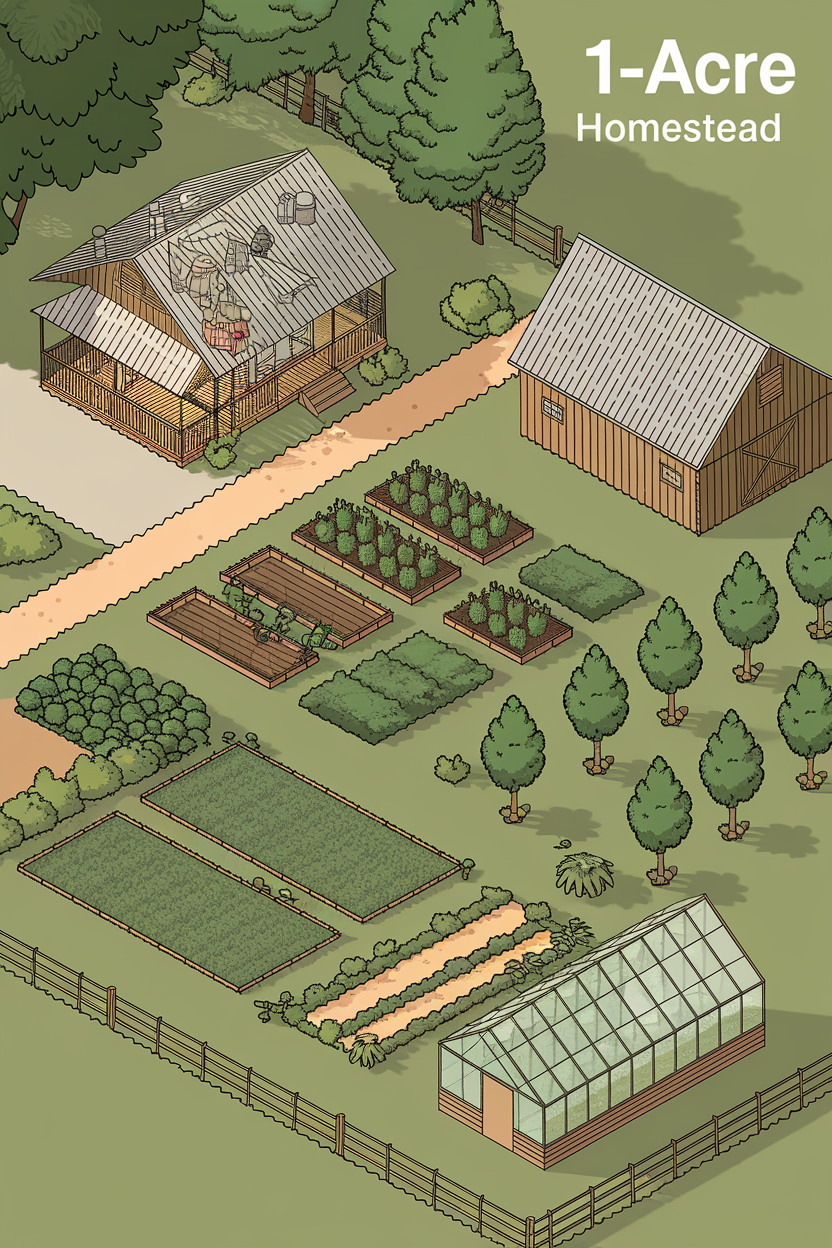1/4 Acre, 0.3 Acres, 1/2 Acre, 1 Acre, 2 Acres, 3 Acres, 5 Acres, 10 Acres, 20 Acres’ Homestead Layout Small Farm.
When designing homestead layouts for various land sizes—whether you’re working with a 1/4 acre, 0.3 acres, 1/2 acre, 1 acre, 2 acres, 3 acres, 5 acres, 10 acres, or even 20 acres—there are a few key principles to keep in mind to make the most of your land, regardless of size.
Each layout will differ based on your priorities, such as sustainable farming, livestock management, or permaculture principles. Let’s break down the optimal use of space for these different acreage sizes, focusing on key aspects like crop cultivation, livestock areas, water management, and self-sufficiency.
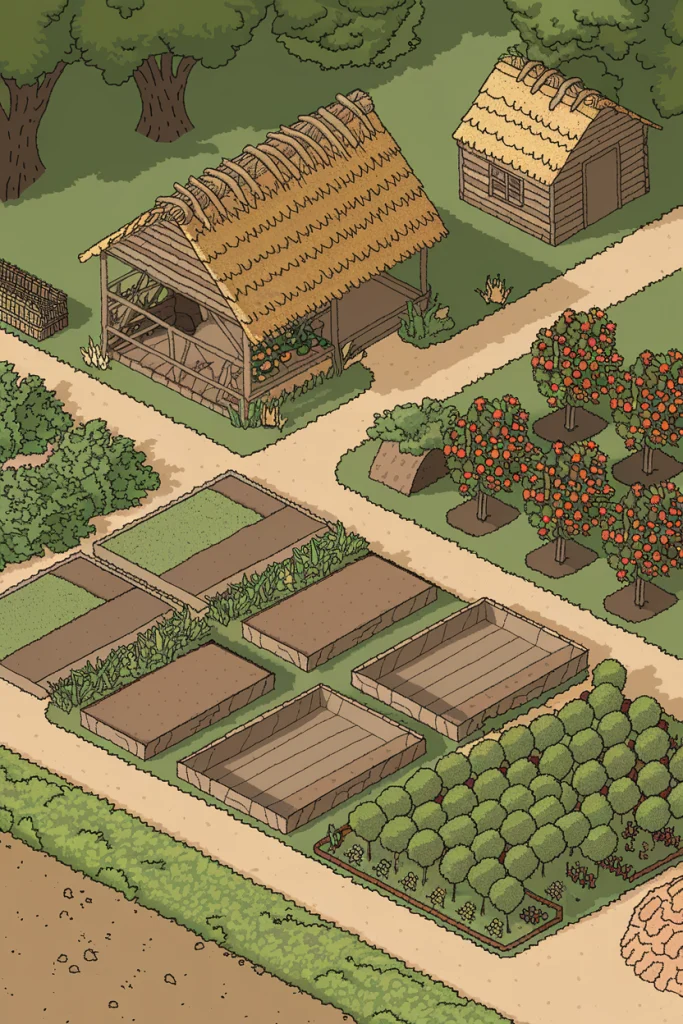
1. 1/4 Acre Homestead Layout
On a 1/4 acre homestead, maximizing space is critical. This land size is ideal for urban or suburban homesteads and can still provide a surprising amount of food production with careful planning.
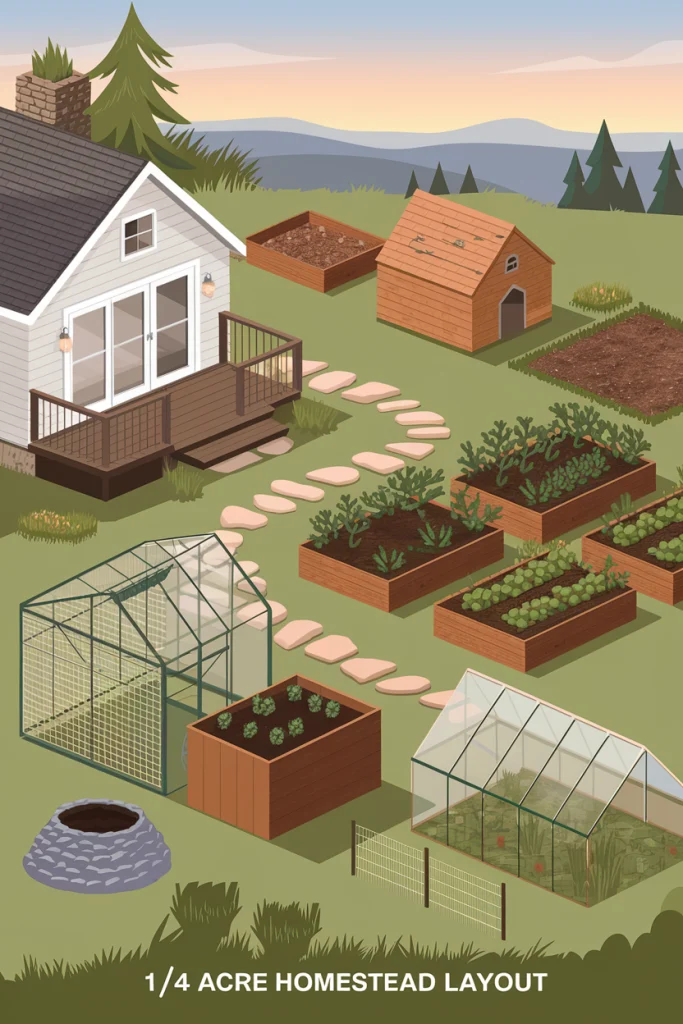
- Key Features:
- Raised garden beds for vegetables and herbs. Using vertical gardening techniques (such as trellises for tomatoes and beans) can help maximize growing space.
- Small chicken coop for egg production. Chickens are low-maintenance and provide valuable manure for composting.
- Compost bin to recycle food waste and create rich, organic fertilizer.
- Water collection system, such as rain barrels, to reduce water usage and improve sustainability.
A 1/4 acre layout can accommodate a couple of small animals like chickens, along with a few fruit trees, but space will be tight. Every square foot should be used strategically.
2. 0.3 Acres Homestead Layout
With 0.3 acres, you have a bit more breathing room. You can start considering small livestock or expanding your crop production.
💥🎁 Christmas & Year-End Deals On Amazon !
Don't miss out on the best discounts and top-rated products available right now!
🛒 Shop Now and Save Big Today!*As an Amazon Associate, I earn from qualifying purchases.
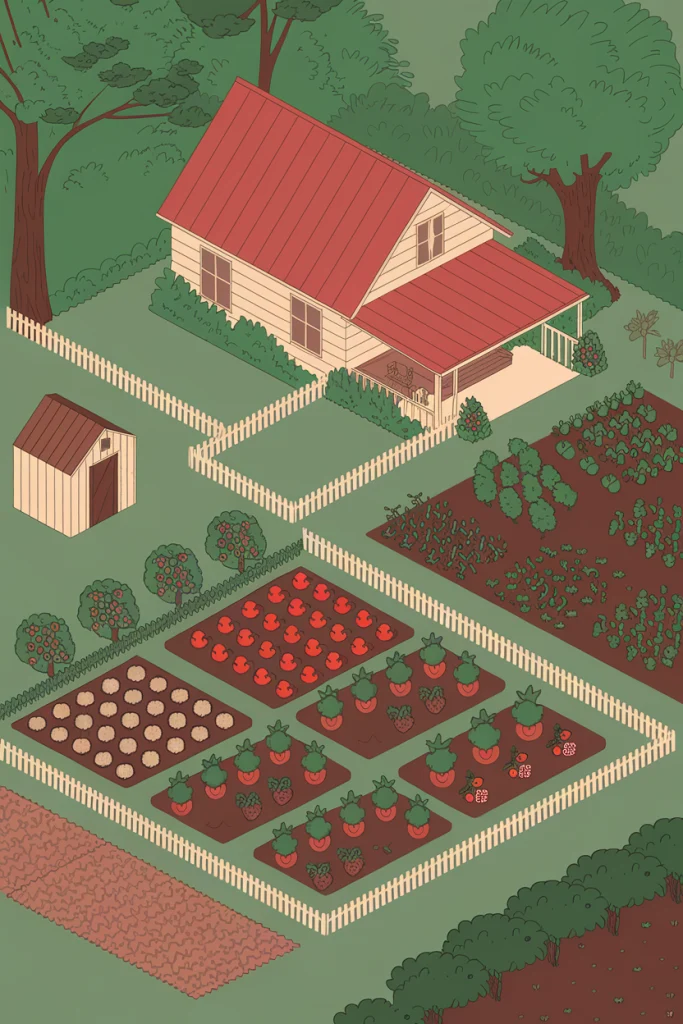
- Key Features:
- Larger garden space, enough to support staple crops like potatoes, beans, or tomatoes.
- Small orchard for dwarf fruit trees like apple, pear, or peach.
- Chicken coop or rabbit hutch for small-scale livestock production.
- Space for a greenhouse to extend your growing season.
At this size, you can begin crop rotation practices, allowing soil recovery and more diverse planting options. Vertical gardening can still play a role, especially in more space-efficient crops like peas, cucumbers, and peppers.
3. 1/2 Acre Homestead Layout
On 1/2 acre, you start to see more flexibility in your homestead design. Here, self-sufficiency begins to become more viable.
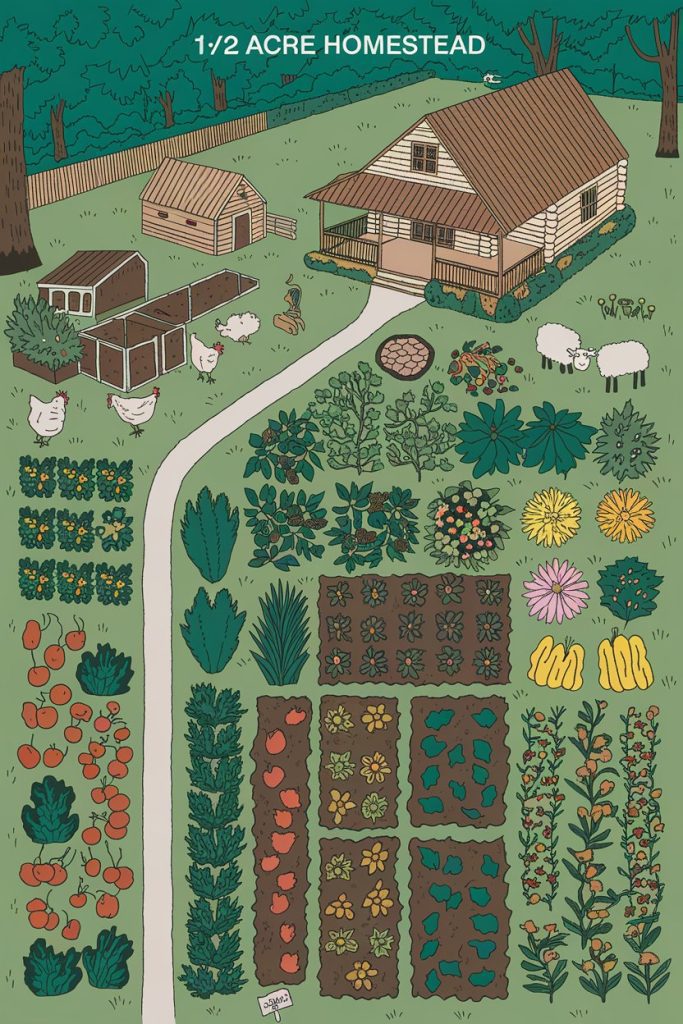
- Key Features:
- Expanded garden space. You can easily grow enough vegetables to feed a small family year-round with proper planning.
- More small livestock, such as chickens or rabbits, and potentially a small goat for milk.
- Compost area and water catchment systems.
- Space for a barn or shed for equipment storage and animal housing.
- Fruit trees, such as apple or peach trees, and even space for berry bushes like raspberries or blueberries.
- Potentially a small beekeeping operation for honey production and pollination.
You can also begin incorporating permaculture zones into your layout, with designated spaces for wildlife, perennials, and annuals.
4. 1 Acre Homestead Layout
With a full acre, your homesteading options increase significantly. You’ll now have space for larger animals and more crops.
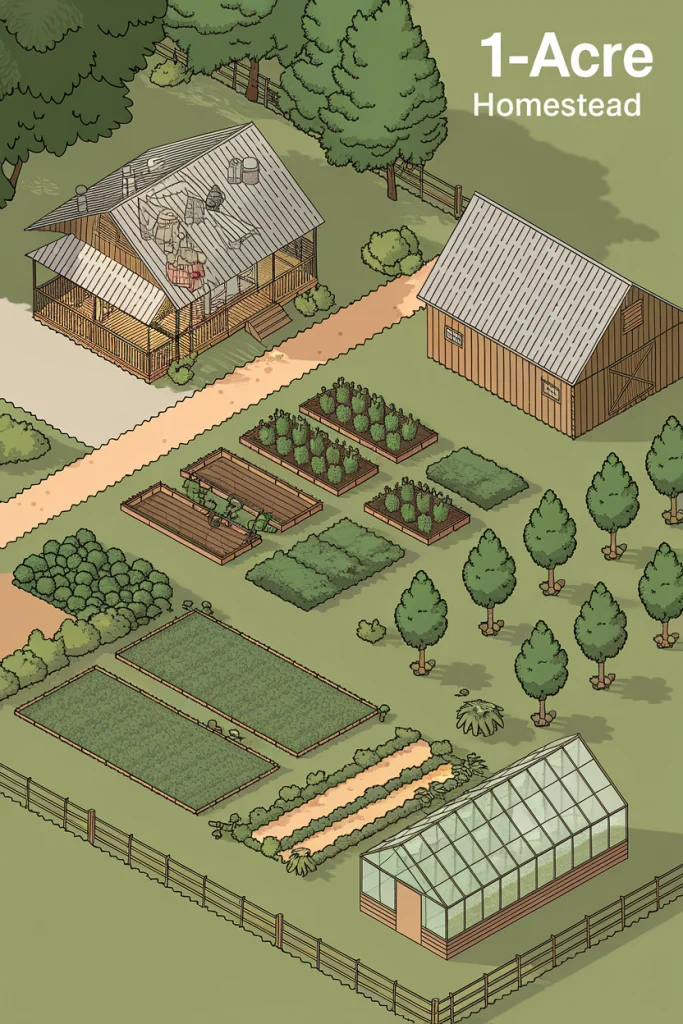
- Key Features:
- Crop rotation plots. At this size, you can have multiple garden plots rotating each season, allowing you to keep the soil fertile.
- Larger livestock options, such as goats for milk or meat, or even a cow.
- Fenced pasture areas for grazing animals.
- Larger fruit orchards and berry patches.
- Greenhouse for year-round growing of sensitive crops.
- Pond for water storage, irrigation, or fish farming (aquaculture).
At one acre, you can also start adding forest gardens—a method of growing fruit, nuts, and other perennials in a way that mimics natural ecosystems, requiring less maintenance and offering high yields.
💥🎁 Christmas & Year-End Deals On Amazon !
Don't miss out on the best discounts and top-rated products available right now!
🛒 Shop Now and Save Big Today!*As an Amazon Associate, I earn from qualifying purchases.
5. 2 Acres Homestead Layout
When you scale up to 2 acres, there’s space for some serious homesteading.
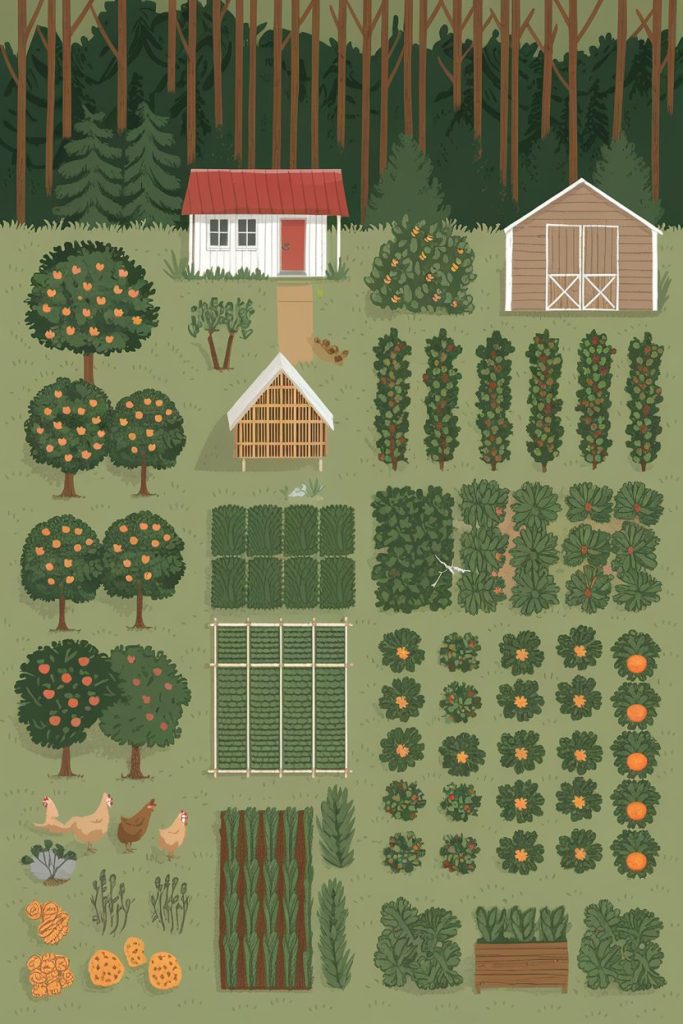
- Key Features:
- Multiple livestock areas: You can now raise a variety of animals, such as pigs, goats, or even a cow.
- Larger crop fields: You can dedicate a significant portion of your land to growing staples like corn, wheat, or even experimenting with grain production.
- Orchard expansion: Room for more fruit trees and diverse plantings like nut trees (walnuts or pecans).
- Dedicated composting areas to create nutrient-rich soil for your crops.
You’ll also have more room for wildlife habitats, windbreaks, or hedgerows to encourage biodiversity, which is crucial for pest control and pollination.
6. 3 Acres Homestead Layout
With 3 acres, you can truly embrace mixed farming and create a robust, diverse farm.
- Key Features:
- Crop diversification: You can plant multiple fields of staple crops, vegetables, and fruit trees.
- Larger livestock operations: Adding cattle for beef or dairy production becomes feasible.
- Room for larger animal housing, barns, and tool storage.
- Water management: Consider adding a pond for fish or irrigation, and using natural water features like creeks or springs.
3-acre layouts can also handle more complex systems, such as intensive rotational grazing, where animals are rotated through small paddocks to improve soil fertility and prevent overgrazing.
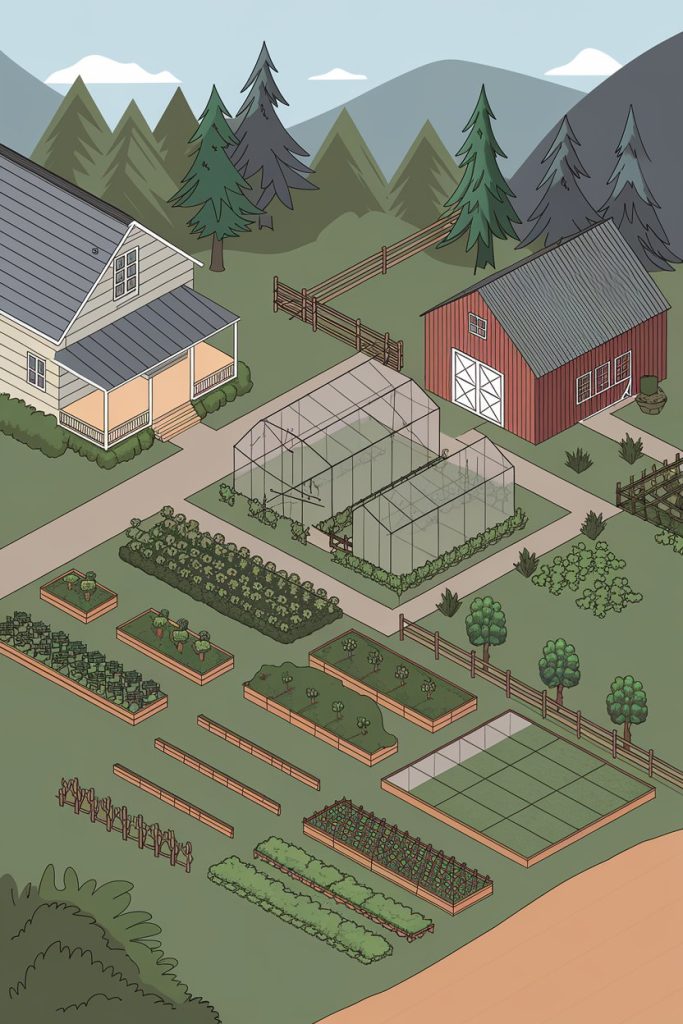
7. 5 Acres Homestead Layout
On a 5-acre farm, the potential for self-sufficiency grows substantially.
💥🎁 Christmas & Year-End Deals On Amazon !
Don't miss out on the best discounts and top-rated products available right now!
🛒 Shop Now and Save Big Today!*As an Amazon Associate, I earn from qualifying purchases.
- Key Features:
- Crop production: You can now cultivate larger grain crops such as wheat, oats, or corn for personal use or for animal feed.
- Animal production: Room for larger herds of livestock, such as cows, pigs, and even small-scale commercial operations.
- Expanded orchards and vineyards for fruits, wine, and jam production.
- Aquaponics or fish farming systems, if you want to integrate water management with food production.
This size homestead can support family farms with produce to sell at markets or to trade with other local homesteaders.
8. 10 Acres Homestead Layout
With 10 acres, you can create a fully operational farm.
- Key Features:
- Large crop fields: Grow enough to sell locally or produce grains for both personal use and animal feed.
- Large-scale livestock operations: You can comfortably raise several head of cattle, pigs, and chickens for both meat and egg production.
- Water systems: Add ponds for irrigation, fish farming, and wildlife habitats.
On 10 acres, you can also start investing in larger-scale sustainability projects, such as solar energy, rainwater harvesting systems, and greenhouses.
9. 20 Acres Homestead Layout
A 20-acre homestead allows you to live off the land and even turn your homestead into a commercial operation.
- Key Features:
- Crop rotation fields: Grow cash crops, or enough staple crops to feed your livestock and family year-round.
- Livestock: Large-scale operations with multiple livestock types—including cows, goats, pigs, and poultry—become feasible.
- Self-sustaining energy systems: Solar, wind turbines, and hydropower from streams on your property.
At 20 acres, you can also set aside large portions for reforestation or silvopasture (combining forestry and grazing), creating diverse ecosystems that support wildlife and regenerative agriculture.
💥🎁 Christmas & Year-End Deals On Amazon !
Don't miss out on the best discounts and top-rated products available right now!
🛒 Shop Now and Save Big Today!*As an Amazon Associate, I earn from qualifying purchases.
Conclusion
Whether you have 1/4 acre or 20 acres, a thoughtful homestead layout can maximize your farm’s output and sustainability.
Larger homesteads allow for more diversity in livestock and crops, while smaller properties can still be highly productive with the right strategies. The key to success is careful planning and sustainable practices tailored to the unique features of your land.
